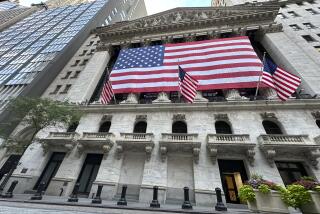Housing Starts Beat Expectations
- Share via
U.S. housing starts were better than expected in May as prospects of rising interest rates did little to damp demand, while industrial production gained in a fresh sign of a strengthening economy, reports released Wednesday showed.
Adding to the picture of gradually gathering economic momentum, the Federal Reserve’s “beige book” report on regional economic conditions said hiring picked up in April and May as potentially worrisome pressures on wages and consumer prices appeared tame.
U.S. housing starts fell 0.7%, a Commerce Department report said, but the drop was less than expected. Permits, an indication of builders’ confidence in future business, rose to a 30-year high -- a seasonally adjusted annual pace of 2.08 million units -- as builders anticipated that higher interest rates would not deter home buyers. Permits for single-family homes reached a record-high annual pace of 1.59 million.
Output at U.S. factories, mines and utilities rose 1.1% in May, the biggest monthly gain in almost six years, the Fed reported.
“The housing starts and industrial production reports suggest that economic activity is going to remain on the stronger side,” said Parul Jain, deputy chief economist at Nomura Securities.
Analysts said housing activity was surprisingly vigorous in the face of likely rate hikes, which would drive mortgage rates up from historically low levels.
Home builders broke ground at a seasonally adjusted annual rate of 1.97 million units in May, down from 1.98 million in April, the Commerce Department said. It was the fourth decline in the last five months, although the single-family-start pace of 1.64 million was the highest since December.
Analysts polled by Reuters had expected starts to post a heftier drop to 1.95 million units.
Meanwhile, building permits jumped unexpectedly by 3.5%, the biggest monthly rise since October. Analysts were expecting permits to ease to 1.97 million units. The 1.1% rise in industrial production was the biggest monthly gain since August 1998. Wall Street had been expecting production to rise about 0.8%.
“It is more evidence that the Fed has to raise rates in June and continue to raise rates throughout the year,” said Eric Green, a senior economist at BNP Paribas.
Although the Fed said unseasonably warm weather drove up utilities’ output, the increase in overall production was broad-based and reflected the continued revival in the U.S. factory sector.
Separately, the Fed said in its anecdotal beige book that hiring increased in most districts but that wages and salaries experienced little upward pressure.
In the Fed district that includes California, the report said, economic activity expanded “at a solid pace” in most areas of the district from mid-April through the beginning of June.
Despite further increases in gas prices, “overall price inflation remained modest. Hiring activity picked up in many areas, but labor generally was in ample supply and upward pressure on wages and salaries was limited,” the report said.
More to Read
Inside the business of entertainment
The Wide Shot brings you news, analysis and insights on everything from streaming wars to production — and what it all means for the future.
You may occasionally receive promotional content from the Los Angeles Times.










